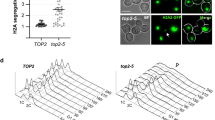Abstract
Double endoreduplication of Chinese hamster CHO-K1 cells that exhibited quadruple chromosomes at metaphase was induced by a combination of rotenone and ammonium vanadate treatments. Analysis of sister chromatid differential staining patterns (using 5-bromo-2′-deoxyuridine) revealed that approximately 50% of the quadruple chromosomes did not keep the scheme of “outside replication” of DNA. Based on the ratio of the staining patterns observed, we suggest that the two diplochromosomes forming a quadruple chromosome are held together by a physical link connecting the two original chromatids. Metaphases with octuple chromosomes were also produced by the same treatment. Each chromosome constituting an octuple chromosome was longer and thinner than ordinary metaphase chromosmes. This suggests incomplete chromosome condensation at metaphase. The majority of octuple chromosomes showed the eight constituent chromosomes to be so enmeshed that a planar alignment could not be observed in air-dried preparations.
Similar content being viewed by others
References
Goyanes VJ, Schvartzman JB (1981) Insights on diplochromosome structure and behaviour. Chromosoma 83:93–102
Herreros B, Giannelli F (1967) Spatial distribution of old and new chromatid sub-units and frequency of chromatid exchanges in induced human lymphocyte endoreduplication. Nature 216:286–288
Matsumoto K, Ohta T (1992) Sensitive period for the induction of endoreduplication by rotenone in cultured Chinese hamster cells. Chromosoma 102:60–65
Matsumoto K, Ohta T (1993) Mitosis of rotenone-induced endore-duplication in Chinese hamster cells. Jpn J Genet 68:185–194
Owusu-Yaw J, Cohen MD, Fernando SY, Wei CI (1990) An assessment of the genotoxicity of vanadium. Toxicol Lett 50:327–336
Rizzoni M, Palitti F (1973) Regulatory mechanism of cell division, I. Colchicine-induced endoreduplication. Exp Cell Res 77:450–458
Ronchi VN, Avanzi S, D'Amato F (1965) Chromosome endoreduplication (endopolyploidy) in pea root meristems induced by 8-azaguanine. Caryologia 18:599–617
Schwarzacher HG, Schnedl W (1965) Endoreduplication in human fibroblast cultures. Cytogenetics 4:1–18
Schwarzacher HG, Schnedl W (1966) Position of labelled chromatids in diplochromosomes of endoreduplicated cells after uptake of tritiated thymidine. Nature 209:107–108
Speit G, Mehnert K, Vogel W (1984) Induction of endoreduplication by hydrazine in Chinese hamster V79 cells and reduced incidence of sister chromatid exchanges in endoreduplicated mitoses. Chromosoma 89:79–84
Sutou S, Tokuyama F (1974) Induction of endoreduplication in cultured mammalian cells by some chemical mutagens. Cancer Res 34:2615–2623
Takanari H (1985) Studies on endoreduplication, V. A three-dimensional scheme for diplo- and quadruple chromosomes and a model for DNA replication. Cytogenet Cell Genet 39:188–193
Takanari H, Nakakuki K, Izutsu K (1985) Cytogenetic demonstration of out-of-phase DNA synthesis in endoreduplicated CHO cells: evidence for partial endoreduplication. Cytogenet Cell Genet 39:93–98
Takayama S, Tachibana K (1980) Two opposite types of sister chromatid differential staining in BUdR-substituted chromosomes using tetrasodium salt of EDTA. Exp Cell Res 126:498–501
Takayama S, Hirano Y, Hiramatsu H (1992) Induction of endoreduplication in double minutes of the human neuroblastoma cells and the replication pattern. Jpn J Genet 67:397–403
Walen KH (1965) Spatial relationships in the replication of chromosomal DNA. Genetics 51:915–929
Wolf S, Perry P (1974) Differential Giemsa staining of sister chromatids and the study of sister chromatid exchanges without autoradiography. Chromosoma 48:341–353
Author information
Authors and Affiliations
Rights and permissions
About this article
Cite this article
Matsumoto, K., Ohta, T. Chemical induction of quadruple and octuple chromosomes in Chinese hamster CHO-K1 cells and relationship between their three-dimensional structure and spatial distribution of BrdU-labeled chromatids. Chromosoma 103, 338–342 (1994). https://doi.org/10.1007/BF00417881
Received:
Revised:
Accepted:
Issue Date:
DOI: https://doi.org/10.1007/BF00417881




